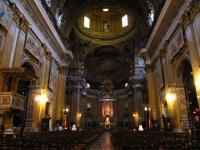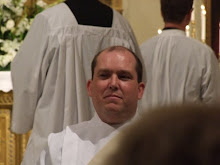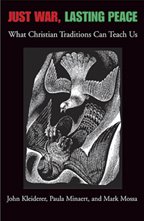God Was One of Us
ST. IGNATIUS' AUTOBIOGRAPHY, part 21
Fourth. When he was at prayer, he often and for a long time saw with the inner eyes the humanity of Christ. The shape which appeared to him was like a white body, not very large or very small, but he saw no distinction of members. He often saw this in Manresa. If he were to say twenty, or even forty times, he would not venture to say it was an untruth. He saw it another time when he was in Jerusalem, and still another when he was on the road near Padua. He has also seen our Lady in like form, without distinction of parts. These things which he saw gave him at the time great strength, and were always a striking confirmation of his faith, so much so that he has often thought to himself that if there were no Scriptures to teach us these matters of faith, he was determined to die for them, merely because of what he had seen.
Fifth. Once out of devotion he was going to a church which was about a mile distant from Manresa, and which I think was called St. Paul. The road ran along close to the river. Moving along intent on his devotion, he sat down for a moment with his face towards the river which there ran deep. As he sat, the eyes of his understanding began to open. He beheld no vision, but he saw and understood many things, spiritual as well as those concerning faith and learning. This took place with so great an illumination that these things appeared to be something altogether new. He cannot point out the particulars of what he then understood, although they were many, except that he received a great illumination in his understanding. This was so great that in the whole course of his past life right up to his sixty-second year, if he were to gather all the helps he received from God, and everything he knew, and add them together, he does not think that they would equal all that he received at that one time.
I suspect that The Spiritual Exercises which Saint Ignatius was formulating at this time was in many ways the fruit of these two experiences. The Exercises are not a theological treatise on the nature of Christ, or things divine. They are a guide to aid the spiritual pilgrim in an encounter with Christ. With Saint Ignatius’ guidance, the exercitant, by becoming a companion to Jesus through the praying of Scripture, gains an understanding of the humanity of Christ which he or she is not likely to have had previously. This is an essential part of the genius of The Exercises—one comes to know Christ as God—and man—intimately. Indeed, Saint Ignatius believed the humanity of Christ to be so important that he hypothesizes that Christ suppresses his divine nature in order that he may most fully enter into the human experience. And if you think about it, it makes sense. If Christ is just God going through the motions of being human, doesn’t that call into question the value of his suffering and death? Besides, Scripture itself seems to portray a Christ that is not certain of what the outcome is going to be. How can that be the case unless Christ has somehow suppressed his own divine knowledge? Might Saint Ignatius even be suggesting that simply the fact that God become one of us is something worth dying for? And isn’t this the kind of passion we as Christians need to have? Kenda Creasy Dean suggests as much in her recent book on youth ministry, Practicing Passion. In it she suggests that what we need to offer young people is a faith worth dying for. That may seem extreme, but aren’t these extreme times?
Saint Ignatius’ final comment, regarding his experience of “infused knowledge,” reminds me of something Saint Thomas Aquinas is credited with saying when he was nearing the end of his life. After writing his extensive works, which would become in many ways the theological backbone of the Church, his comment was that everything he had written was but straw. Like Saint Ignatius, I suspect he caught a brief glimpse of the truth of God and realized that everything he had ever learned, thought or written could only scratch the surface of God’s reality. As hard as it is to fathom and understand Jesus as at once fully God and fully human, this is child’s play in comparison with what is one day to be revealed to us when we become companions of Christ in God’s heavenly kingdom.
Fourth. When he was at prayer, he often and for a long time saw with the inner eyes the humanity of Christ. The shape which appeared to him was like a white body, not very large or very small, but he saw no distinction of members. He often saw this in Manresa. If he were to say twenty, or even forty times, he would not venture to say it was an untruth. He saw it another time when he was in Jerusalem, and still another when he was on the road near Padua. He has also seen our Lady in like form, without distinction of parts. These things which he saw gave him at the time great strength, and were always a striking confirmation of his faith, so much so that he has often thought to himself that if there were no Scriptures to teach us these matters of faith, he was determined to die for them, merely because of what he had seen.
Fifth. Once out of devotion he was going to a church which was about a mile distant from Manresa, and which I think was called St. Paul. The road ran along close to the river. Moving along intent on his devotion, he sat down for a moment with his face towards the river which there ran deep. As he sat, the eyes of his understanding began to open. He beheld no vision, but he saw and understood many things, spiritual as well as those concerning faith and learning. This took place with so great an illumination that these things appeared to be something altogether new. He cannot point out the particulars of what he then understood, although they were many, except that he received a great illumination in his understanding. This was so great that in the whole course of his past life right up to his sixty-second year, if he were to gather all the helps he received from God, and everything he knew, and add them together, he does not think that they would equal all that he received at that one time.
I suspect that The Spiritual Exercises which Saint Ignatius was formulating at this time was in many ways the fruit of these two experiences. The Exercises are not a theological treatise on the nature of Christ, or things divine. They are a guide to aid the spiritual pilgrim in an encounter with Christ. With Saint Ignatius’ guidance, the exercitant, by becoming a companion to Jesus through the praying of Scripture, gains an understanding of the humanity of Christ which he or she is not likely to have had previously. This is an essential part of the genius of The Exercises—one comes to know Christ as God—and man—intimately. Indeed, Saint Ignatius believed the humanity of Christ to be so important that he hypothesizes that Christ suppresses his divine nature in order that he may most fully enter into the human experience. And if you think about it, it makes sense. If Christ is just God going through the motions of being human, doesn’t that call into question the value of his suffering and death? Besides, Scripture itself seems to portray a Christ that is not certain of what the outcome is going to be. How can that be the case unless Christ has somehow suppressed his own divine knowledge? Might Saint Ignatius even be suggesting that simply the fact that God become one of us is something worth dying for? And isn’t this the kind of passion we as Christians need to have? Kenda Creasy Dean suggests as much in her recent book on youth ministry, Practicing Passion. In it she suggests that what we need to offer young people is a faith worth dying for. That may seem extreme, but aren’t these extreme times?
Saint Ignatius’ final comment, regarding his experience of “infused knowledge,” reminds me of something Saint Thomas Aquinas is credited with saying when he was nearing the end of his life. After writing his extensive works, which would become in many ways the theological backbone of the Church, his comment was that everything he had written was but straw. Like Saint Ignatius, I suspect he caught a brief glimpse of the truth of God and realized that everything he had ever learned, thought or written could only scratch the surface of God’s reality. As hard as it is to fathom and understand Jesus as at once fully God and fully human, this is child’s play in comparison with what is one day to be revealed to us when we become companions of Christ in God’s heavenly kingdom.






2 Comments:
Teilhard also wrote about a vision he had at a church. He explained it in great detail, and it reminded me of the visions Ignatius wrote about. He said he was dumbfounded by it, and he only 'caught a glimpse of it once again, in the glance of a dying soldier.' A vision of Christ in the glance of a dying soldier - now that stuck with me.
I am giving a talk on the mystics for a women's group in July. I have always been struck by their attepmts to define the undefinable.
Our Pal Thomas once said it is easier to say what God is not. I have always tried to remember that and not put human limits on God's loving possibilities.
Maggie
Post a Comment
<< Home